The Study of Metamorphic Rocks, Zonation and Isogrades in Garnet Rocks in the Hamadan Area
Zahra Hossein Mirzaei Beni1 * and Zahreh Hossein Mirzaei Beni1
1
Young Research Club, Khorasgan (Isfahan) Branch,
Islamic Azad University,
Isfahan,
Iran
DOI: http://dx.doi.org/10.12944/CWE.7.1.10
The study area is a part of the Sanandaj- Sirjan metamorphic belt. We can divide Hamadan metamorphic rocks in three groups: regional metamorphic rocks, contact metamorphic rocks and migmatites. In this area we can’t completely divide zonation of contact and regional metamorphic. In some places that contact metamorphic has influenced to low degree regional metamorphic rocks, contact metamorphic zonations are clearly appear, but when contact and regional metamorphic have a same degree or regional metamorphic has high degree than contact metamorphic, we can’t distinguish them easily. In Hamadan area regional metamorphic zones are Chlorite± Biotite zone (we haven’t garnet rocks in this zone), Biotite± Garnet zone (divided in two sub zone, Biotite and Garnet zone), Andalusite zone, Staurolite zone, Staurolite± Andalusite zone, Sillimanite- Muscovite zone and Sillimanite- Potassium feldspar± Cordierite zone, also contact metamorphic zones are Cordierite zone and Cordierite- Potassium feldspar zone.
Copy the following to cite this article:
Beni ZHM, Beni ZHM. The Study of Metamorphic Rocks, Zonation and Isogradesin Garnet Rocks in the Hamadan Area. Curr World Environ 2012;7(1):55-59 DOI:http://dx.doi.org/10.12944/CWE.7.1.10
Copy the following to cite this URL:
Beni ZHM, Beni ZHM. The Study of Metamorphic Rocks, Zonation and Isogrades in Garnet Rocks in the Hamadan Area. Curr World Environ 2012;7(1):55-59. Available from: http://www.cwejournal.org/?p=1811
Download article (pdf) Citation Manager Publish History
Select type of program for download
| Endnote EndNote format (Mac & Win) | |
| Reference Manager Ris format (Win only) | |
| Procite Ris format (Win only) | |
| Medlars Format | |
| RefWorks Format RefWorks format (Mac & Win) | |
| BibTex Format BibTex format (Mac & Win) |
Article Publishing History
| Received: | 2012-03-03 |
|---|---|
| Accepted: | 2012-04-15 |
Introduction
Garnet crystallizes in cubic system and mostly in dodecahedron (rhomb-dodecahedron) and trapezohedron (tetragon-trioctahedron) crystal forms. General chemical formula of this mineral is: R3R’2(SiO4)3, which bivaliant cations (i.e. Mg2+, Fe2+, Mn2+, Ca2+) lie in R site and trivaliant cations (i.e. Al3+, Cr3+, Fe3+) in R’ site. Commonly, more than one cation lies in R and R’ sites and therefore garnet crystals give rise to isomorphous (solid solution) series of minerals. If Al3+ is located in R’ site, the pyralspite group [( Fe2+,Mg2+,Mn2+ )3 Al2(SiO4)3] with almandine [(Fe2+)3 Al2 (SiO4)3], pyrope [(Mg2+)3Al2 (SiO4)3] and spessartine [(Mn2+)3Al2(SiO4)3] end members will form. If Ca2+ is located in R site, the ugrandite group [(Ca2+)3 (Al3+,Fe3+,Cr3+)2(SiO4)3] with grossularite[Ca3Al2(SiO4)3], and radite [Ca3(Fe3+)2 (SiO4)3] and uvarovite [Ca3(Cr3+)2(SiO4)3] end members will form. Some other cations may also be emplaced in R and R’ sites.1,2 The garnet minerals chemistry in the study area are rich in almandine.
Geological Setting
The study area is a part of the Sanandaj-Sirjan metamorphic belt. The Alvand plutonic complex is the most important plutonic body that regional and contact metamorphic rocks with low to high grade are located around it. The metamorphic sequence comprises pelitic, psammitic, basic, calc-pelitic and calc-silicate rocks. Pelitic rocks are the most abundant lithologies. Pelitic sequence is mostly made up of slates, phillites, micaschists, garnet schists, garnet andalusite (± sillimanite, ± kyanite) schists, garnet staurolite schists, mica hornfelses, garnet hornfelses, garnet andalusite (± fibrolite) hornfelses, cordierite (± andalusite) hornfelses, cordierite K-feldspar hornfelses and sillimanite K-feldspar hornfelses. Major plutonic rocks of this area are granitoids, diorites and gabbroids, which intruded by aplo-pegmatitic and silicic veins
(Figure 2Ms + 6Qtz + 2H+ → 3Prl + 2K ...(5) 1).
Metamorphic Zonation and Isogrades of Garnet Rocks in Study Area
In this area we can’t completely divide zonation of contact and regional metamorphic. In some places that contact metamorphic has influenced to low degree regional metamorphic rocks, contact metamorphic zonations are clearly appear, but when contact and regional metamorphic have a same degree or regional metamorphic has high degree than contact metamorphic, we can’t distinguish them easily.
The metamorphic reaction and thermobarometric studies of metamorphic rocks have shown that garnet mica schist forming at 4.3 ±0.5 Kbar and 568-586 ºC and garnet hornfelses at 2.5 ±0.1 Kbar and 539-569 ºC [3].
Regional Metamorphic Rocks Low Grade Rocks (Chl Zone)
The lowest-grade rocks are very fine grained black,green or cream colored slates and phyllites, interlayered with carbonate rocks and quartzites. Slates contain Quart, Sericite, Chlorite, Graphite, Iron oxides. Phyllites contain Quart, Muscovite, Chlorite, Plagioclase, +/-Garnet, +/-Biotite, as well as accessory Tourmaline, Calcite and Iron oxides. Samples of metamorphic reaction that have shown in this zone are:
Kln + 2Qtz→ Prl + H2O ...(4)
Biotite and Garnet Zone
These rocks are medium to coarse grained and their common texture is lepidoporphyroblastic with a usual crenulation cleavage. This zone divided in two sub zone, biotite and garnet zone. They are composed of Quartz, Biotite, Garnet (up to 10 mm in size), Muscovite, Chlorite, with accessory Plagioclase, Graphite, Tourmaline, Apatite, Calcite and Iron oxides (Figure 2). Common porphyroblasts are Garnet, Muscovite and Chlorite. Garnet crystals have complex relationship to deformation, i.e. they are pre-, syn- and post-tectonic. The metamorphic reaction and thermobarometric studies of metamorphic rocks have shown that garnet mica schist forming at 4.3 ±0.5 Kbar and 568-586 ºC [3].
Chl + Ms → Grt + Bt + Qtz + H2O ...(6)
2Chl + 4Qtz → 3Grt + 8H2O ...(7)
Chiastolite Zone
These rocks are medium to coarsed grained with a common lepidoporphroblastic texture. Their common minerals are Quartz, Biotite, Andalusite (up to 20 cm length), Garnet, Muscovite and minor Graphite, Chlorite, Plagioclase, Tourmaline, Apatite, Sillimanite and Iron oxides (Figure 3).
Grt + Ms + Qtz And + Bt + H2O ...(8)
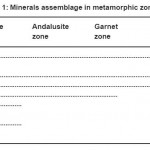 |
Table 1: Minerals assemblage in metamorphic zonation Click here to View table |
![fig01 Fig. 1: Simplified zonation map of the Hamadan area [10]](http://www.cwejournal.org/wp-content/uploads/2012/09/fig012-150x150.jpg) |
Figure 1: Simplified zonation map of the Hamadan area10 Click here to View table |
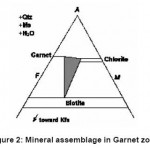 |
Figure 2: Mineral assemblage in Garnet zone Click here to View table |
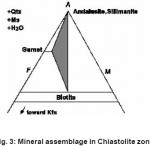 |
Figure 3: Mineral assemblage in Chiastolite zone Click here to View table |
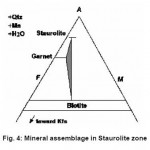 |
Figure 4: Mineral assemblage in Staurolite zone Click here to View table |
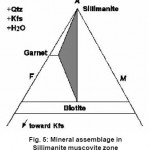 |
Figure 5: Mineral assemblage in Sillimanite muscovite zone Click here to View table |
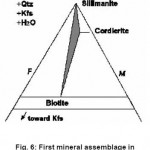 |
Figure 6: First mineral assemblage in Sillimanite- potassium feldspar zone Click here to View table |
Staurolite Zone
These rocks are composed of Quartz, Staurolite, Garnet, Biotite, Muscovite, Chlorite, Plagioclase, Graphite and Tourmaline (Figure 4). Their common texture is lepidoporphyroblastic with porphyroblasts of garnet, staurolite (up to 15 cm in legnth).
Grt + Chl +Ms + Qtz → St + Bt + H2O ...(8)
Sillimanite muscovite zone
Sillimanite andalusite schists contain Quartz, Sillimanite (± andalusite), Biotite, Muscovite, Garnet, Plagioclase and Opaque minerals (Figure 5).
Grt + Ms + Qtz →Sil + Bt + H2O ...(8)
Sillimanite-Potassium Feldspar Zone
High grade schists and Migmatites are in this zone. The high grade schists in the regional metamorphic sequence contain Sillimanite, Quartz, Biotite, Muscovite, Garnet, Plagioclase, Potassium feldspar, ±Andalusite,±Kyanite, ±Staurolite (Figure 6).
Migmatites are a sequence of metatexite-diatexite rocks with various structures such as stromatic, schollen, schlieric and massive. The melanosome mineralogy of the most of the metatexites is very similar to high grade Garnet sillimanite (± andalusite and kyanite) schists but Cordierite-bearing interlayers occur, too (Figure 7). Leucosome of migmatites have granoblastic texture and contain Quartz, Plagioclase, Muscovite and ±Garnet.
Bt + Ab + Sil + Qtz → Grt + Kfs + L
Contact Metamorphic Rocks
Protoliths of the contact metamorphic rocks are similar to those in the regional metamorphic sequence and include abundant metapelitic rocks. Two metamorphic zones are widespread around plutonic bodies.
Cordierite Zone
The major rock types in this zone are Cordierite hornfelses. This rocks have porphrogranoblastic texture that containing Quartz, Biotite, Muscovite,contact Cordierite (± andalusite), Plagioclase, Garnet, Tourmaline and Opaque minerals (Figure 8). garnet hornfelses forming at 2.5 ±0.1 Kbar and 539-569 ºC.3
Chl + H2O → Grt + H2O ...(7)
Cordierite potassium feldspar zone
The typical mineral assemblage of these rock is Quartz, contact Cordierite (Crd2), orthoclase, Biotite, minor Plagioclase, Garnet and Opaque minerals (Figure 9).
Bt + Sil (± And) + Qtz → Crd + Kfs + H2O ...(7)
Minerals assemblage in metamorphic zonation are shown in table 1.
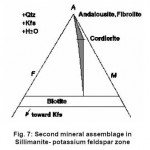 |
Figure 7: Second mineral assemblage in Sillimanite- potassium feldspar zone Click here to View table |
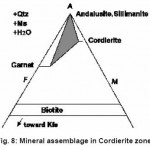 |
Figure 8: Mineral assemblage in Cordierite zone Click here to View table |
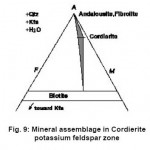 |
Figure 9: Mineral assemblage in Cordierite potassium feldspar zone Click here to View table |
Conclusion
We can divide Hamadan metamorphic rocks in three groups: regional metamorphic rocks, contact metamorphic rocks and migmatites. In this area regional metamorphic zones are Chlorite± Biotite zone, Biotite± Garnet zone, Andalusite zone, Staurolite zone, Staurolite± Andalusite zone, Sillimanite- Muscovite zone and Sillimanite-Potassium feldspar ± Cordierite zone, also contact metamorphic zones are Cordierite zone and Cordierite- Potassium feldspar zone.
References
- Locock, A., An Excel spreadsheet torecast analyses of garnet end-member componets, and a synopsis of the crystal chemistry of natural silicate garnets. Computers and Geosciences. V, 34: 1769-1780 (2008).
- Li Li, H., Kuang, X., Mao, A., Li, Y. and Wang, S., Study of local structures and optical spectra for octahedral Fe3+ centers in a series of garnet crystals A3B2C3O12 (A = Cd, Ca; B = Al, Ga, Sc, In; C = Ge, Si). Chemical Physics Letters, 484: 387-391 (2010)
- Sepahi, A. A., Whitney D. L. and Baharifar A. A., , Petrogenesis of andalusite-kyanite-sillimanite veins and their host rocks, Sanandaj-Sirjan metamorphic belt, Hamadan, Iran. J. Met. Geol, 22:119-134 (2004).
- Thompson, A.B., A note on the kaolinite-pyrophyllite equilibrium. Am. J. Sci, 268: 454-458 (1970).
- Frey, M., Progressive Low grade metamorphism of a Black Shale Formation, Central Swiss Alps, with special reference to pyrophyllite and margarite bearing assemblages. J. Petrol, 19: 95-135 (1978).
- Whitney, D.L., Mechum, T.A. and Dilek, Y.R., Progressive metamorphism of pelitic rocks from protolith to granulite facies. Dutchess County, New York, USA: Constraints on the timing of fluid infiltration during regional metamorphism. J. Met. Geol, 74: 163-181 (1996).
- Kretz, R., Metamorphic crystallization. John Wiley and Sons, 507 (1994).
- Yang, P. and Pattison, D., Genesis of monazite and Y zoning in garnet from the Black Hills, South Dakota. J. Lithos, 88: 233-253 (2006).
- Norlander, B.H., Whitney, D.L., Teyssier, C. and Vanderhaeghe, O., Partial melting and decompression of the Thor-Odin Dome, Shuswap metamorphic core complex. Canada. Cord. Lithos, 61: 103-125 (2002).
- Sepahi, A.A., Typology and petrogenesis of granitic rocks in the Sanandaj-Sirjan metamorphic belt, Iran: With emphasis on the Alvand plutonic complex. N. Jb. Geol. Palaton. Abn, 247: 295-312 (2008).







